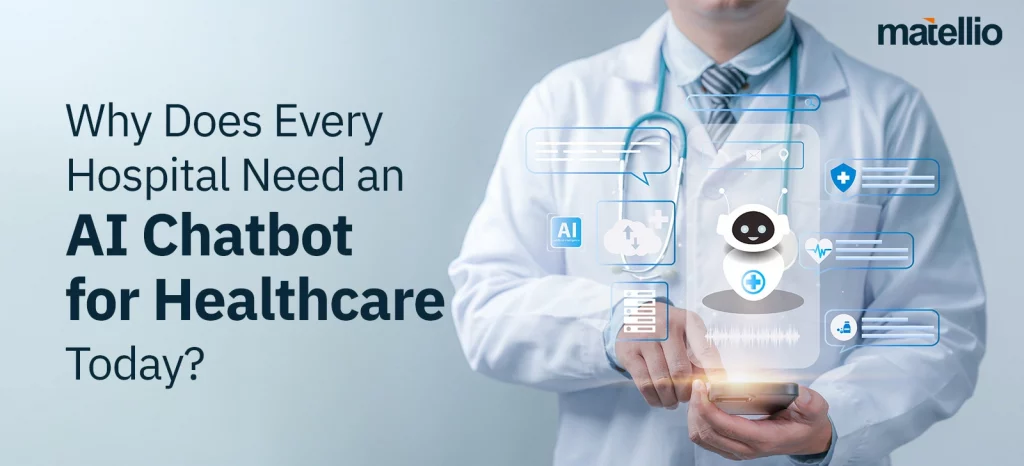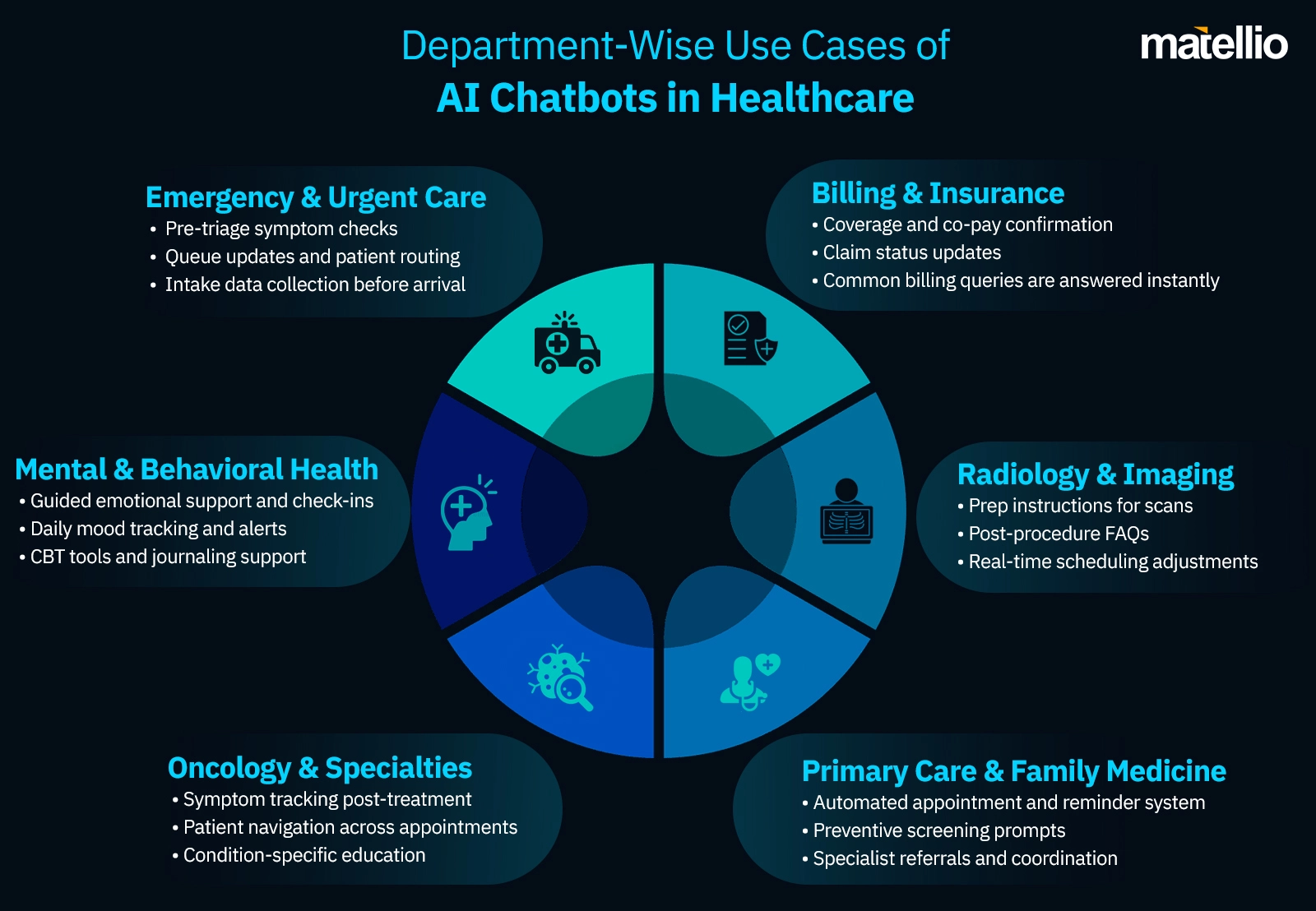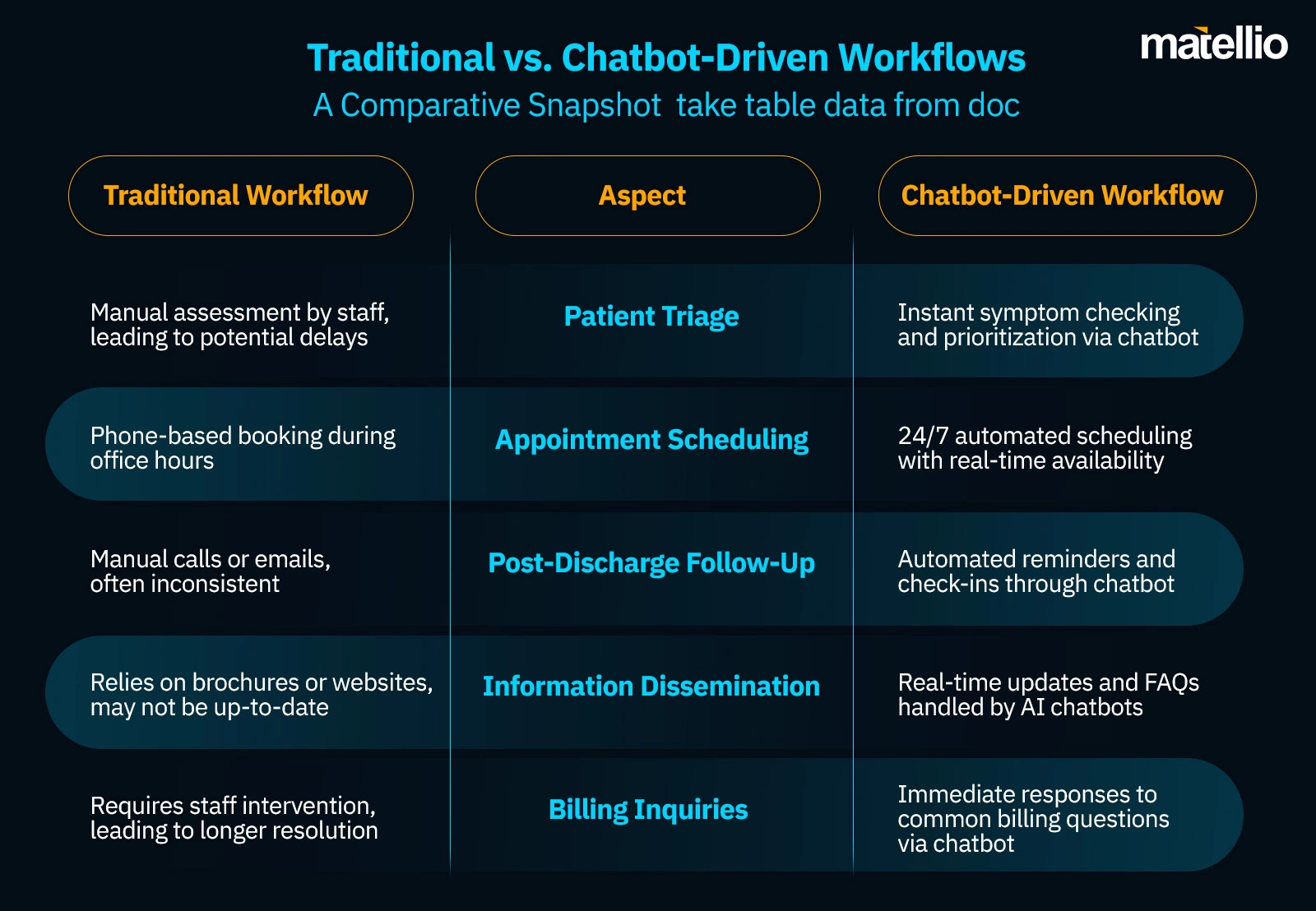
In today’s healthcare landscape, patients expect immediate, seamless communication with their providers. However, many care teams are still grappling with outdated systems, limited staffing, and overwhelming administrative demands—leading to long wait times, missed follow-ups, and frustrated patients. Enter the AI chatbot for healthcare—a scalable, intelligent companion that bridges the communication gap.
By automating high-volume, low-complexity interactions like appointment booking, FAQs, follow-ups, and symptom pre-screening, AI chatbots free up human staff for more critical and personalized care needs. The result? Faster response times, better patient satisfaction, and significant operational lift.
And this shift isn’t just anecdotal—it’s accelerating fast. According to recent projections, the global healthcare chatbots market was valued at USD 1.20 billion in 2024 and is expected to reach USD 10.26 billion by 2034, growing at a CAGR of 23.92% from 2025 to 2034. This sharp upward trend reflects the growing confidence in conversational AI as a core layer in healthcare delivery—not just a tech add-on.
As the pressure to do more with less intensifies, AI chatbots are no longer optional—they’re essential for healthcare organizations aiming to stay patient-centric, efficient, and future-ready.
The Silent Strain: Why Healthcare Teams Need an AI Chatbot for Healthcare Now
While the face of healthcare is advancing, the backend chaos often tells a different story. Providers are burned out, patients are left waiting, and vital communication is slipping through the cracks. Below are the everyday challenges silently draining efficiency—challenges an AI chatbot for healthcare is uniquely positioned to solve:
Unmanageable Inflow at the Front Desk
With increasing patient volumes and limited admin staff, handling calls, bookings, and walk-in queries becomes a bottleneck. Staff juggle dozens of tasks simultaneously, leading to missed calls, delays, and reduced face time with in-clinic patients. A robust chatbot solution for healthcare industry can absorb these volumes effortlessly while maintaining response quality and speed.
Inconsistent Post-Discharge Communication
Patients often leave the clinic with little to no structured follow-up. This leads to missed medication, no-shows for reviews, and preventable readmissions. Manual reminders simply don’t scale with volume, but a chatbot for healthcare systems using AI ensures continuity of care through automated check-ins and medication alerts.
Repetitive Administrative Workload
Clinicians and front-line staff spend hours addressing the same basic questions daily—”What’s my co-pay?”, “What time is my appointment?” “Do you offer weekend slots?”. These repetitive, low-value tasks divert focus from urgent care needs. An enterprise AI chatbot development service can automate such interactions at scale, freeing up staff bandwidth.
Lack of 24/7 and Multilingual Support
Most healthcare providers only operate within fixed hours and in one or two languages, alienating patients who need help after-hours or in their native tongue—especially in diverse urban regions. Using AI for healthcare chatbots and virtual assistants, care teams can ensure every patient receives timely, culturally aware support.
Fragmented Initial Data Capture
The first point of patient interaction (like a phone call or email) often fails to collect structured, actionable data. As a result, clinicians walk into appointments with missing context, leading to repetitive questioning and wasted time. A well-integrated AI chatbot development approach allows you to capture and sync this information directly with EHR systems.
Strategic Features of AI Chatbot for Healthcare That Drive Operational Impact
The modern AI chatbot is no longer just a convenience tool—it’s a strategic extension of clinical care. As AI in healthcare evolves, chatbots are stepping up with intelligent features that go far beyond simple automation. From real-time triage to behaviour-driven engagement, these next-gen capabilities are transforming both operational workflows and the patient experience across the board. Below is a breakdown of the most impactful features from both the business and user perspectives:
Business Perspective
AI chatbots in healthcare are more than digital front-desk agents—they are powerful engines for efficiency, cost savings, and improved care coordination. Here’s how next-gen features deliver value to healthcare organizations:
| Feature | Impact on Healthcare Business |
| 24/7 Automated Triage | Reduces staff load and triage costs by handling high-volume queries |
| EHR Integration | Streamlines data flow and minimizes manual data entry errors |
| Sentiment & Tone Detection | Flags critical cases for faster escalation, improving clinical outcomes |
| Multilingual Chatbot Support | Expands access to underserved populations without hiring extra staff |
| Custom Care Pathways | Tailors workflows to different departments and specialties |
| Appointment & Reminder Bot | Cuts down on missed appointments, improving resource utilization |
| Compliance-Driven Messaging | Ensures HIPAA/GDPR adherence, reducing legal and data breach risks |
| Behavior-Based Engagement | Enhances patient retention with proactive, personalized follow-ups |
User Perspective
From accessibility to personalization, the AI chatbot in healthcare is fast becoming a trusted digital companion for patients. Here’s what today’s users can expect from these next-gen tools:
| Feature | How It Improves Patient Experience |
| 24/7 Availability | Offers instant answers at any hour, reducing stress during off-hours |
| Personalized Interactions | Adapts tone, flow, and content based on user input and emotional cues |
| Multilingual Conversations | Enables comfort and clarity through native language communication |
| Easy Scheduling & Reminders | Provides one-click appointment booking and follow-up nudges |
| Medication Tracking & Reminders | Supports adherence with friendly prompts and progress logs |
| Symptom Checker & Pre-Triage | Helps users assess symptoms before clinical visits |
| Data Privacy Transparency | Builds trust by showing how personal data is used and protected |
| Longitudinal Memory | Remembers past conversations for seamless, ongoing support |
Tech Behind the Chat: What Powers an AI Chatbot for Healthcare
An effective AI chatbot for healthcare isn’t built on simple scripts—it’s engineered with cutting-edge technologies that enable real-time support, data privacy, and clinical-grade intelligence. Here’s a breakdown of the core components powering today’s most impactful healthcare bots:
 Natural Language Processing (NLP) & Sentiment Analysis
Natural Language Processing (NLP) & Sentiment Analysis
NLP enables chatbots to understand medical terminology, user intent, and context in real time. Sentiment analysis takes it further—detecting stress, frustration, or urgency in a patient’s tone and adjusting responses accordingly. This emotional intelligence allows bots to sound more human, supportive, and responsive during sensitive interactions. As part of a well-structured chatbot solution for healthcare industry, NLP ensures that patients feel understood, not just processed.
 Machine Learning for Prediction & Escalation
Machine Learning for Prediction & Escalation
With machine learning algorithms, chatbots continuously learn from user interactions to improve the accuracy of their responses. They can predict patient needs (e.g., likelihood of appointment no-show or medication non-adherence) and trigger smart escalations when symptoms worsen—automatically alerting clinicians when intervention is needed. These capabilities are foundational to any chatbot for healthcare system using AI, enabling proactive, patient-centric care.
 EHR Integration & Secure Messaging Protocols
EHR Integration & Secure Messaging Protocols
Modern chatbots integrate with EHR platforms like Epic, Cerner, and MEDITECH to sync appointment details, medical history, allergies, and lab results in real-time. Encrypted messaging protocols ensure that all data exchanges are secure and traceable. This level of integration is a core deliverable within any AI chatbot development strategy focused on interoperability and clinical efficiency.
 HIPAA/GDPR Compliance Frameworks
HIPAA/GDPR Compliance Frameworks
Data privacy isn’t optional—especially in healthcare. AI chatbots must comply with HIPAA and GDPR regulations, employing role-based access control, end-to-end encryption, anonymized data handling, and detailed audit trails. These elements are standard within compliant AI chatbot development services, ensuring that healthcare organizations can scale safely and ethically.
 Pre-Trained Medical Language Models
Pre-Trained Medical Language Models
To ensure clinical relevance, top-tier chatbots are now powered by specialized models like Bio BERT, MEd Palm, or Clinical BERT—trained on real-world medical texts and case studies. These models enhance a chatbot’s ability to handle complex queries with medical accuracy. When built by experienced teams offering AI Based Chatbot Development Services, these models turn conversational tools into clinical-grade digital assets. A BERT-based medical chatbot has demonstrated an accuracy of 98% in handling medical queries.
Explore What an AI Chatbot Can Do for Your Healthcare System!
From Manual to Magical: What the Numbers Say
The integration of AI chatbots for healthcare isn’t just a technological advancement—it’s a transformative shift that’s delivering tangible results. Here’s what leading studies and reports reveal about their impact:
 Cost Savings and Efficiency Gains
Cost Savings and Efficiency Gains
A report by Juniper Research estimates that by 2023, the adoption of chatbots across sectors like healthcare will result in annual cost savings of $11 billion, up from $6 billion in 2018.
 Enhanced Patient Experience
Enhanced Patient Experience
According to Accenture, 64% of patients are likely to switch healthcare providers if their expectations aren’t met, emphasizing the importance of efficient and responsive care.
 Bridging Communication Gaps
Bridging Communication Gaps
The World Health Organization (WHO) utilized chatbots during public health crises to disseminate accurate information, correct misinformation, and reduce public anxiety, highlighting their role in enhancing communication during critical times.
Future Outlook: Where AI Chatbots Are Headed in Healthcare
As healthcare continues to embrace intelligent automation, AI chatbots are rapidly evolving from basic assistants to intelligent, proactive care companions. These five trends outline how they’re shaping the next wave of digital transformation.
Wearable-Powered Nudging
By integrating with fitness trackers and smart health devices, AI chatbots will actively monitor real-time vitals and behavior to offer timely prompts—whether it’s hydration reminders or alerting care teams. This is where AI chatbots for healthcare unlock their full preventive potential by keeping patients engaged outside clinical walls.
Conversational Pre-Diagnostics
AI-driven bots will soon use symptom analysis and patient history to generate predictive assessments. In this evolution, a chatbot for healthcare system using AI will help triage patients even before they reach a doctor—saving valuable time, streamlining resource allocation, and improving early intervention outcomes.
Mental Health Check-Ins
From anxiety tracking to CBT-based prompts, future bots will provide sensitive, day-to-day mental health support. This deep emotional engagement marks a key area of growth for AI for healthcare chatbots and virtual assistants, especially where traditional in-person services are limited or inaccessible.
Memory-Driven Personalization
AI chatbots will retain conversation history, clinical inputs, and behavioral patterns to personalize patient interactions. Through solutions offered by advanced AI chatbot development services, this longitudinal memory will lead to highly tailored responses that improve care continuity and patient satisfaction.
Cultural & Language Fluency
Tomorrow’s chatbots won’t just translate—they’ll adapt their tone and style to align with cultural sensitivities and regional preferences. This next-gen personalization will be powered by human-centric Conversational AI Services, bringing equity and relatability to every digital touchpoint.
The Matellio Approach: AI Chatbot Solutions Built for Clinical Realities
At Matellio, we don’t just build chatbots—we architect intelligent, compliant, and scalable AI chatbot for healthcare solutions that address the real-world complexities of modern clinical environments. Whether you’re operating a multi-specialty hospital, a primary care chain, or a behavioral health network, our approach ensures your chatbot isn’t just functional—it’s truly transformative.
- We begin by designing custom conversational flows tailored to your speciality workflows—whether it’s pre-op screening in surgery, post-discharge engagement in cardiology, or triage automation in urgent care. Every use case is mapped with clinical accuracy and tested for operational feasibility using our proven expertise in AI chatbots for healthcare deployments.
- Our engineering teams ensure seamless integration with your existing IT stack, including EHR platforms, telehealth systems, scheduling tools, and internal communication frameworks—ensuring no disruption to your core operations. This is where our AI integration services deliver true value, making intelligent automation work across every layer of your infrastructure.
- Every solution is delivered with enterprise-grade security and compliance. Our AI chatbot deployments are HIPAA and GDPR aligned, scalable across departments, and built with multilingual capabilities to serve diverse patient populations with clarity and empathy. This is what sets us apart as a trusted AI chatbot development company in the digital health ecosystem.
- Most importantly, our commitment doesn’t end at deployment. We provide ongoing performance monitoring, analytics-driven optimization, and full support so your chatbot evolves with your organization’s goals and patient expectations.
The Question Isn’t If—It’s How Soon
The need for intelligent, scalable communication in healthcare is no longer optional—it’s strategic. Delayed triage, missed follow-ups, and rising patient expectations demand real-time, AI-driven engagement.
With Matellio’s deep expertise in AI chatbot development for healthcare, you’re not just keeping up—you’re setting the pace. Ready to redefine patient engagement, reduce operational burdens, and unlock scalable automation?
Fill out the form to contact our healthcare AI experts. Let’s build your next-gen healthcare chatbot!

 Natural Language Processing (NLP) & Sentiment Analysis
Natural Language Processing (NLP) & Sentiment Analysis Machine Learning for Prediction & Escalation
Machine Learning for Prediction & Escalation EHR Integration & Secure Messaging Protocols
EHR Integration & Secure Messaging Protocols HIPAA/GDPR Compliance Frameworks
HIPAA/GDPR Compliance Frameworks Pre-Trained Medical Language Models
Pre-Trained Medical Language Models Cost Savings and Efficiency Gains
Cost Savings and Efficiency Gains Enhanced Patient Experience
Enhanced Patient Experience Bridging Communication Gaps
Bridging Communication Gaps


